Crafting perfect herbal teas with a mortar and pestle elevates your tea-making experience. Start by selecting a suitable mortar, like a 6-inch stone or ceramic set. Choose versatile herbs such as chamomile, peppermint, and lemon balm as your base. Clean your workspace and tools thoroughly before beginning. Use gentle grinding techniques, adjusting pressure based on the herb type. Experiment with flavor combinations, balancing base herbs (50-60%) with complementary and accent herbs. Measure carefully, using 1-2 teaspoons of dried herbs per cup of water. Store your blends in airtight containers away from light and heat. With practice, you'll reveal a world of aromatic possibilities and personalized tea creations.
Choosing the Right Mortar Pestle

Before diving into herbal tea preparation, selecting the right mortar and pestle is essential. You'll want to take into account the material, size, and texture of your grinding tools. Traditional materials include stone, ceramic, wood, and metal, each offering unique benefits.
Stone mortars, particularly granite, are durable and excellent for grinding herbs finely. Ceramic options are versatile and easy to clean but can be fragile. Wooden sets are gentle on delicate herbs but may absorb flavors over time. Metal mortars are best for crushing harder ingredients but can react with acidic components.
Size matters too. A 6-inch diameter mortar is suitable for most home tea preparations. Make sure the pestle fits comfortably in your hand for easy grinding.
The interior texture of the mortar should be slightly rough to aid in crushing herbs effectively. Smooth surfaces won't grip the ingredients well, making grinding more difficult.
Evaluate your specific needs when choosing. If you'll be working with a variety of herbs, a versatile stone or ceramic set might be ideal. For gentler grinding of delicate leaves, opt for a wooden mortar and pestle.
Essential Herbs for Tea Blending
To create your own herbal tea blends, you'll need to familiarize yourself with common tea herbs and their flavor profiles.
Start with versatile options like chamomile, peppermint, and lemon balm, which pair well with many other herbs.
As you experiment, you'll discover exciting combinations that suit your taste preferences and desired effects.
Common Tea Herb Varieties
A wealth of herbs awaits the aspiring tea blender. You'll find many common varieties that are perfect for creating delicious and healthful herbal teas.
Chamomile, known for its calming properties, is a popular choice for evening blends. Peppermint offers a revitalizing and invigorating flavor, while spearmint provides a milder alternative. Lemon balm adds a citrusy note and is believed to reduce stress.
For a spicy kick, consider ginger or cinnamon. These warming herbs not only taste great but may also aid digestion.
Lavender imparts a floral aroma and is often used to promote relaxation. Rosehips, rich in vitamin C, contribute a tangy flavor and lovely pink hue to your blends.
Don't overlook the power of common culinary herbs like thyme, sage, and rosemary, which can add depth and complexity to your teas.
For those seeking adaptogenic benefits, holy basil (tulsi) and ashwagandha are excellent choices.
Flavor Profile Combinations
Now that you're familiar with common tea herbs, let's explore how to combine them for ideal flavor profiles. Start with a base herb like chamomile, peppermint, or rooibos, which will form the foundation of your blend. Then, add complementary herbs to enhance or balance the flavor.
For a soothing bedtime blend, combine chamomile with lavender and lemon balm. The floral notes of lavender complement chamomile's apple-like taste, while lemon balm adds a subtle citrus undertone.
If you're looking for an invigorating morning tea, mix peppermint with rosemary and a touch of ginger. The coolness of peppermint pairs well with rosemary's piney aroma, while ginger adds a spicy kick.
For a revitalizing summer blend, try combining hibiscus with lemongrass and a hint of stevia for sweetness. The tart hibiscus balances nicely with the citrusy lemongrass.
If you're after a warming winter tea, blend cinnamon, ginger, and cardamom for a spicy chai-like flavor.
Don't be afraid to experiment with different combinations to find your perfect blend.
Preparing Your Workspace
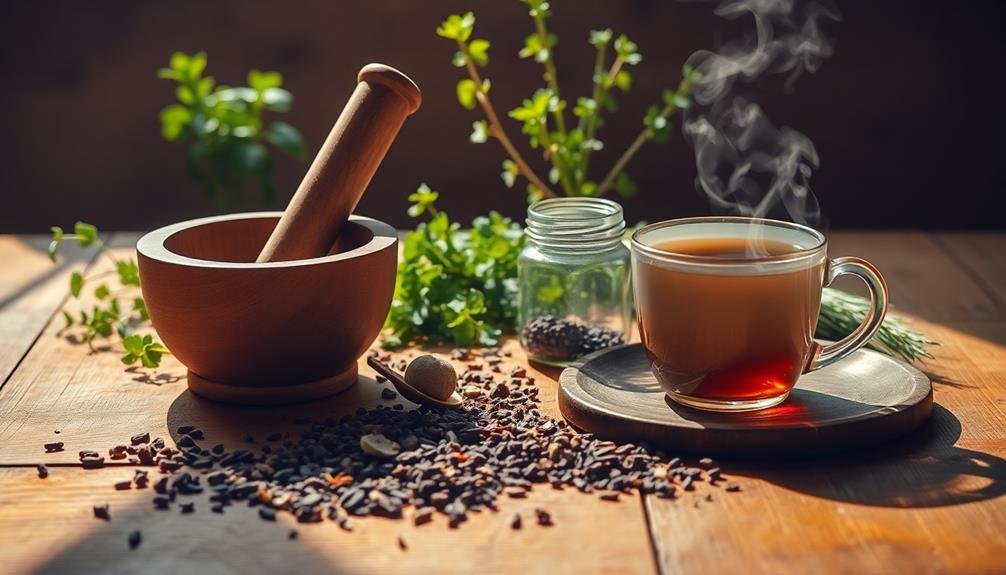
Before you begin blending your herbal teas, it's essential to prepare your workspace properly.
Start by thoroughly cleaning and sanitizing all surfaces you'll be using, then gather your mortar and pestle, measuring tools, and storage containers.
Efficiently organize your chosen herbs and ingredients within easy reach to streamline your tea-making process.
Clean and Sanitize Surfaces
Consistently maintaining a clean workspace is essential when preparing herbal teas with a mortar and pestle. Before you begin, thoroughly clean all surfaces with warm, soapy water and rinse them well. For added safety, sanitize your work area with a food-grade sanitizing solution. You can make this by mixing one tablespoon of unscented bleach with a gallon of water.
Don't forget to clean and sanitize your mortar and pestle, too. If they're made of stone, avoid using soap, as it can be absorbed into the porous material. Instead, grind uncooked rice in the mortar to remove any residue, then rinse with hot water.
For wooden tools, use a mild soap and hot water, then dry them immediately to prevent warping.
Verify your hands are clean by washing them with soap and warm water for at least 20 seconds. If you're using herbs from your garden, rinse them thoroughly to remove any dirt or debris.
Gather Necessary Equipment
Gathering the necessary equipment is an essential step in preparing your workspace for making herbal teas with a mortar and pestle. You'll need to collect several items to guarantee a smooth and efficient process. Start by selecting a high-quality mortar and pestle set, preferably made of granite or marble for durability and ease of cleaning.
Next, gather your herbs and spices, guaranteeing they're fresh and properly stored. You'll also need measuring spoons, a kitchen scale, and airtight containers for storing your finished blends. Don't forget to have a strainer or tea infuser on hand for brewing your tea.
Here's a quick reference table for the essential equipment you'll need:
| Equipment | Purpose |
|---|---|
| Mortar and pestle | Grinding herbs and spices |
| Measuring spoons | Accurate ingredient portioning |
| Kitchen scale | Precise herb measurements |
| Airtight containers | Storing finished tea blends |
Lastly, prepare clean towels or paper towels for wiping down surfaces and your hands. Having all these items ready before you begin will help streamline your herbal tea-making process and guarantee a more enjoyable experience.
Organize Ingredients Efficiently
Efficiency is key when organizing your ingredients for herbal tea preparation. Start by sorting your herbs and spices into categories based on their properties or flavors. Group aromatic herbs like mint and lavender together, while keeping stronger-tasting herbs like ginger or cinnamon separate.
Place these groups in small bowls or on clean, labeled plates for easy access.
Next, measure out your ingredients according to your recipe. Use small measuring spoons or a kitchen scale for precision. Pre-measuring saves time and reduces the risk of over or under-seasoning your tea blend.
If you're creating multiple blends, consider using a divided container or muffin tin to keep each blend's components separate.
Arrange your tools within arm's reach. Place your mortar and pestle centrally, with your measured ingredients to one side and empty containers for your finished blends on the other.
Keep a small brush nearby for cleaning the mortar between blends. If you're using additional items like a tea infuser or strainer, position them nearby as well.
This organized setup will streamline your workflow, allowing you to move smoothly from one step to the next without interruption.
Grinding Techniques for Herbs
The art of grinding herbs requires finesse and practice to achieve ideal results. When using a mortar and pestle, start with a gentle approach. Place a small amount of dried herbs in the mortar and hold the pestle firmly. Begin with a circular grinding motion, pressing down with moderate force. As you grind, increase pressure gradually to break down the herbs more thoroughly.
For leafy herbs, use a crushing technique. Hold the pestle vertically and press down in short, controlled motions. This method works well for herbs like mint or basil.
For tougher ingredients like roots or bark, employ a pounding technique. Lift the pestle and strike downward with controlled force, then twist to grind further.
Pay attention to consistency as you work. You'll want a fine powder for most teas, but some recipes may call for coarser grinds. Don't overfill the mortar; work in small batches for best results.
If you're mixing multiple herbs, grind them separately before combining to guarantee even distribution. Remember, the finer the grind, the stronger the flavor and faster the infusion in your tea.
Balancing Flavors in Tea Blends
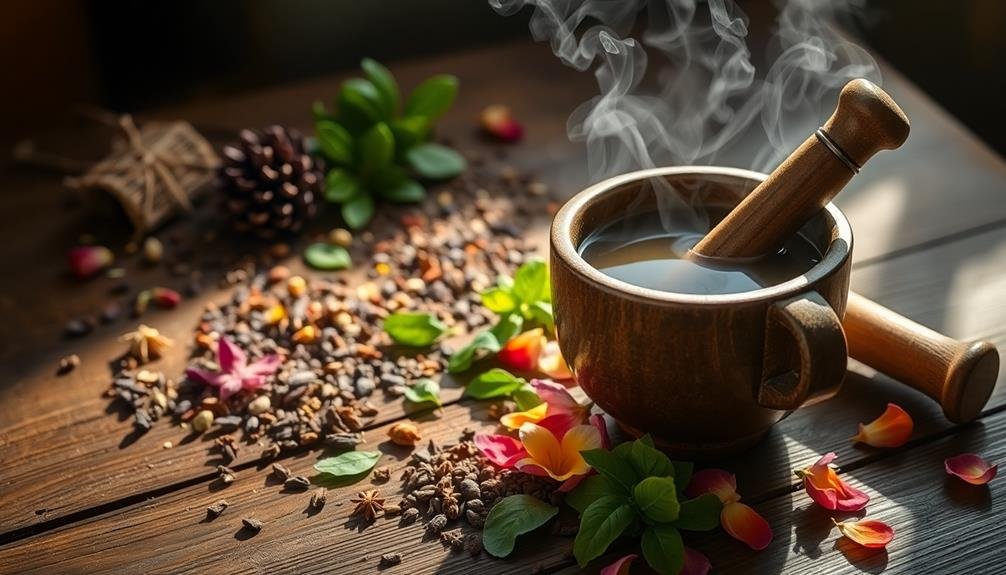
Creating a harmonious tea blend is both an art and a science. You'll need to balance flavors, aromas, and therapeutic properties to craft a satisfying blend. Start by selecting a base herb that'll make up about 50-60% of your mixture. This could be chamomile for relaxation or peppermint for digestion.
Next, add complementary herbs to enhance the flavor profile and health benefits. Consider these common combinations:
| Base Herb | Complementary Herb | Accent Herb |
|---|---|---|
| Chamomile | Lavender | Lemon Balm |
| Peppermint | Spearmint | Fennel |
| Rooibos | Cinnamon | Vanilla |
| Green Tea | Jasmine | Lemongrass |
Use your mortar and pestle to gently crush herbs, releasing their essential oils. This'll intensify flavors and aromas. Remember, strong-flavored herbs like peppermint or ginger should be used sparingly to avoid overpowering other ingredients.
Taste-test your blend and adjust proportions as needed. You might add a pinch of stevia for sweetness or a touch of citrus peel for brightness. Don't be afraid to experiment with unusual combinations – you might discover your new favorite blend!
Measuring and Proportions
When crafting herbal teas, you'll need to pay close attention to precise ingredient ratios to achieve the desired flavor and potency.
You'll want to maintain a proper balance between herbs and water, typically using 1-2 teaspoons of dried herbs per cup of water.
As you become more familiar with your ingredients, you can adjust these proportions based on the potency of specific herbs and your personal taste preferences.
Precise Ingredient Ratios
Achieving the perfect balance in your herbal tea blend requires precise ingredient ratios. When using a mortar and pestle, you'll need to pay close attention to the proportions of each herb to create a harmonious flavor profile.
Start by determining your base herb, which typically makes up 50-70% of the blend. This could be chamomile, peppermint, or rooibos, depending on your desired taste and effects.
Next, add your secondary herbs, which should comprise 20-30% of the mix. These often provide complementary flavors or additional health benefits.
Finally, include accent herbs or spices, making up the remaining 10-20% of the blend. These add depth and complexity to your tea.
For example, a calming bedtime blend might consist of 3 parts chamomile (base), 1 part lemon balm (secondary), and 1/2 part lavender (accent).
As you become more familiar with different herbs' strengths and characteristics, you can adjust these ratios to suit your taste preferences. Remember to record your measurements and proportions, allowing you to replicate successful blends and refine your recipes over time.
Herbs-To-Water Balance
The proper herbs-to-water ratio is essential for brewing the perfect cup of herbal tea. You'll want to strike a balance between flavor intensity and water volume. Generally, use 1-2 teaspoons of dried herbs or 2-3 teaspoons of fresh herbs per cup of water. However, this can vary depending on the herb type and personal preference.
When using a mortar and pestle, you'll have more control over the herb's texture, which can affect the brewing process. Finely ground herbs release flavor more quickly but may become bitter if steeped too long. Coarsely ground herbs release flavor more slowly, requiring longer steeping times.
Here's a quick reference guide for common herbal teas:
| Herb Type | Amount per Cup | Steeping Time |
|---|---|---|
| Chamomile | 1-2 tsp dried | 5-7 minutes |
| Peppermint | 1-2 tsp fresh | 3-5 minutes |
| Ginger | 1 tsp grated | 5-10 minutes |
| Lavender | 1/2 tsp dried | 5-7 minutes |
| Lemon Balm | 1-2 tsp fresh | 5-7 minutes |
Adjusting for Potency
Frequently, you'll need to adjust the potency of your herbal tea to suit your taste preferences or desired effects. The key to achieving the right strength lies in understanding the potency of your herbs and adjusting your measurements accordingly.
Start by using a digital scale to weigh your herbs precisely. For most dried herbs, a general rule of thumb is 1-2 teaspoons per cup of water. However, this can vary greatly depending on the herb's potency and your desired outcome. For stronger herbs like peppermint or ginger, you might use less, while milder herbs like chamomile may require more.
When using a mortar and pestle, grinding your herbs can increase their potency. Finely ground herbs will release their flavors and beneficial compounds more quickly, resulting in a stronger brew. If you prefer a milder taste, grind the herbs less or use them whole.
Don't hesitate to experiment with different proportions. Keep a journal of your measurements and brewing times to find your perfect balance. Remember, you can always add more herbs if the tea is too weak, but you can't remove them once they're steeped.
Storing Your Herbal Tea Blends
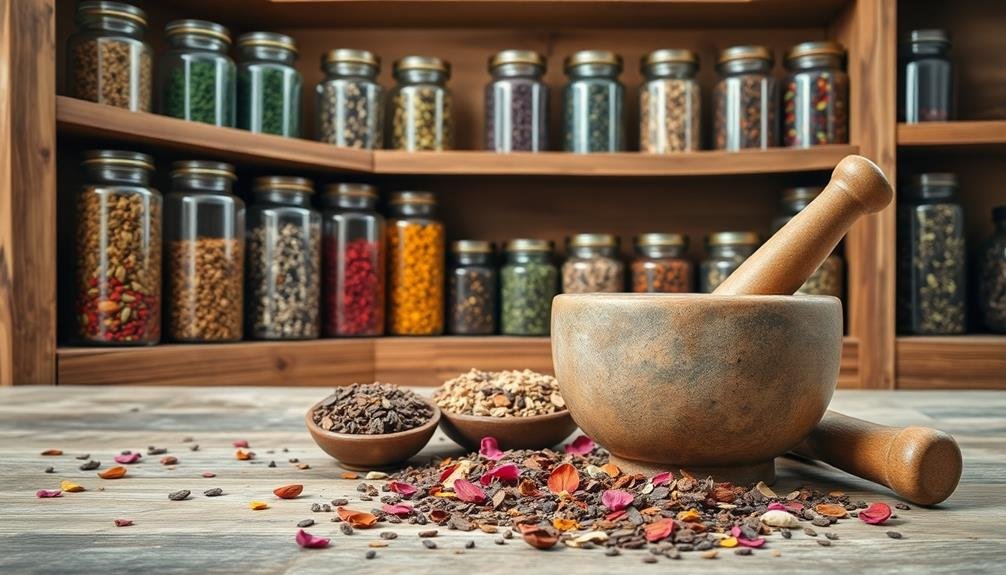
Proper storage is essential for maintaining the freshness and potency of your herbal tea blends. After crafting your perfect mix with a mortar and pestle, you'll want to guarantee it stays in top condition. Store your blends in airtight containers, preferably made of glass or ceramic, as these materials won't impart any unwanted flavors or odors.
Keep them away from direct sunlight, heat, and moisture, which can degrade the herbs' quality. Label each container with the blend's name and date of creation. This practice helps you track freshness and use older blends first.
Most herbal tea blends will retain their flavor and potency for about six months to a year when stored properly. However, some herbs may lose their effectiveness more quickly.
Consider storing larger quantities of individual herbs separately and mixing smaller batches as needed. This approach allows you to maintain the freshness of each component and adjust your blends over time.
If you notice any changes in color, aroma, or taste, it's time to replace your blend. By following these storage guidelines, you'll guarantee that your carefully crafted herbal tea blends remain vibrant and effective for as long as possible.
Steeping Methods for Optimal Flavor
Mastering the art of steeping is essential for extracting ideal flavor from your herbal tea blends. To achieve best results, start by heating water to the appropriate temperature. For most herbal teas, use water that's just off the boil, around 200°F (93°C). However, delicate herbs like chamomile or mint benefit from slightly cooler water, around 190°F (88°C).
Place your herbal blend in a tea infuser or directly in your cup. Use about 1 teaspoon of herbs per 8 ounces of water, adjusting to taste. Pour the hot water over the herbs and cover the cup to retain heat and volatile oils. Steep for 5-10 minutes, depending on the herbs and desired strength. Longer steeping times can extract more beneficial compounds but may result in a stronger, sometimes bitter flavor.
For cold brewing, use room temperature water and steep in the refrigerator for 4-12 hours. This method produces a smoother, less astringent taste.
Experiment with different steeping times and temperatures to find your perfect balance. Remember, some herbs release their flavors more quickly than others, so you may need to adjust your technique for each unique blend.
Health Benefits of Homemade Teas
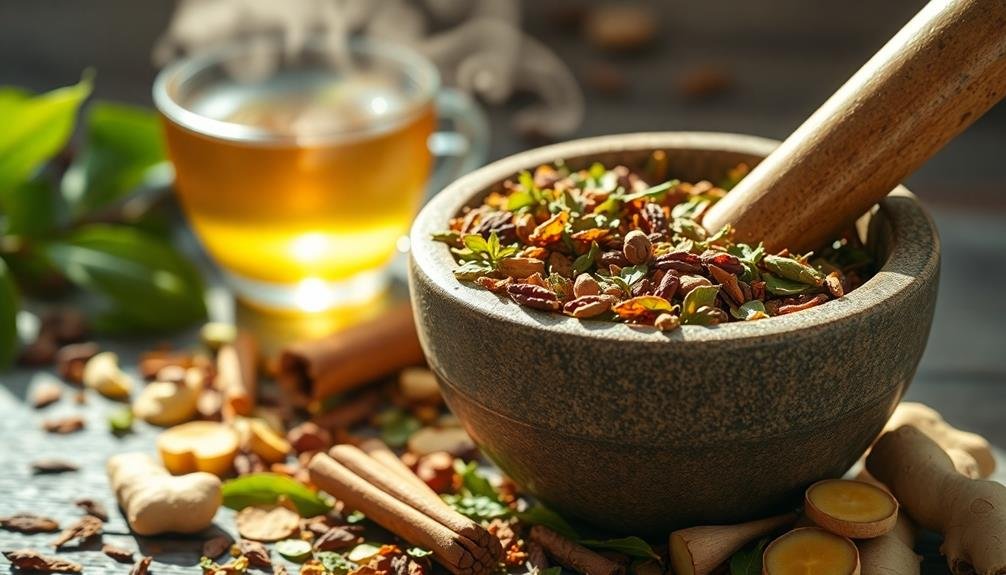
While perfecting your steeping technique enhances flavor, it's the health benefits of homemade herbal teas that make them truly special. By crafting your own blends, you're in control of the ingredients, ensuring you're getting the most potent and pure herbs without additives or preservatives.
Homemade herbal teas offer a wide range of health benefits, depending on the herbs you choose. Chamomile can help reduce anxiety and improve sleep quality, while peppermint may aid digestion and relieve headaches. Ginger tea can boost your immune system and reduce inflammation, making it an excellent choice during cold and flu season.
When you use a mortar and pestle to prepare your herbs, you're:
- Releasing essential oils for maximum potency
- Preserving delicate plant compounds that might be lost in pre-packaged teas
- Creating a sensory experience that enhances mindfulness and relaxation
Seasonal Herbal Tea Recipes
Seasons bring unique flavors and health needs, making them perfect inspirations for herbal tea blends. You'll find that crafting seasonal teas with a mortar and pestle allows you to tailor your brews to nature's rhythms. For spring, try a revitalizing blend of lemon balm, nettle, and dandelion to support detoxification. Summer calls for cooling herbs like mint, hibiscus, and lemongrass to beat the heat.
As autumn approaches, warming spices like cinnamon, ginger, and turmeric can boost your immunity. Winter's chill is best met with comforting blends of elderberry, echinacea, and thyme to ward off colds. Here's a quick guide to seasonal tea ingredients:
| Season | Herb 1 | Herb 2 | Herb 3 |
|---|---|---|---|
| Spring | Lemon Balm | Nettle | Dandelion |
| Summer | Mint | Hibiscus | Lemongrass |
| Autumn | Cinnamon | Ginger | Turmeric |
| Winter | Elderberry | Echinacea | Thyme |
Remember to grind your herbs freshly for each blend. You'll notice the difference in flavor and potency compared to pre-packaged teas. Experiment with ratios to find your perfect seasonal cup, and don't be afraid to add local, foraged ingredients for a truly personalized blend.
Pairing Teas With Food
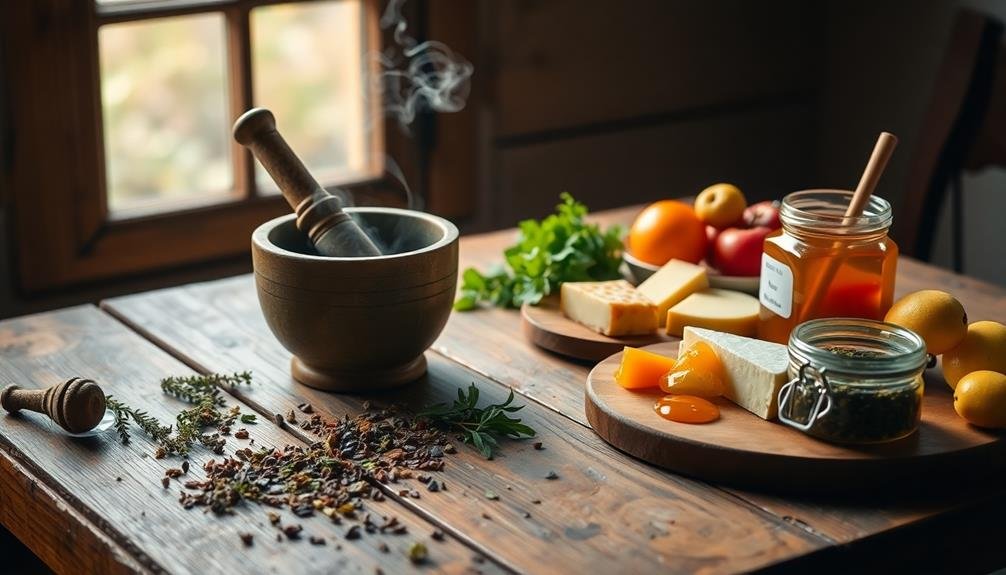
Just as wine enthusiasts pair their favorite vintages with complementary dishes, tea connoisseurs can enhance their culinary experiences by matching herbal teas with food.
When pairing teas with meals, consider the flavors, aromas, and intensities of both the tea and the dish. Light, invigorating teas like peppermint or chamomile work well with delicate foods such as salads or seafood. Robust, full-bodied teas like ginger or cinnamon can stand up to heartier fare like grilled meats or spicy curries.
Don't be afraid to experiment with unexpected combinations. You might discover that a citrusy lemongrass tea perfectly complements a rich chocolate dessert, or that an earthy rooibos tea brings out the flavors in a savory cheese plate.
Here are some classic pairings to get you started:
- Lavender tea with lemon tart or shortbread cookies
- Hibiscus tea with spicy Mexican dishes or fruity desserts
- Chamomile tea with light pastries or afternoon tea sandwiches
Gifting Your Handcrafted Tea Blends
Creating your own tea blends isn't just a treat for yourself; it's an opportunity to share your passion with others. When you've mastered the art of crafting herbal teas with a mortar and pestle, consider gifting your unique creations to friends and family.
Start by selecting attractive packaging that preserves the tea's freshness and showcases its beauty. Small glass jars, tin containers, or resealable pouches work well. Label each blend with its name, ingredients, and brewing instructions. You can add a personal touch by including a handwritten note explaining the blend's inspiration or health benefits.
Consider creating themed gift sets, such as a "relaxation" collection featuring chamomile, lavender, and lemon balm, or an "energizing" set with peppermint, ginger, and green tea. You might also pair your tea blends with complementary items like honey, a tea infuser, or a small mortar and pestle set to encourage recipients to explore tea-making themselves.
Don't forget to include storage instructions to maintain the tea's quality. Your thoughtful, handcrafted gift won't only delight the recipient but also introduce them to the joys of artisanal tea blending.
Cleaning and Maintaining Your Mortar

Proper care of your mortar and pestle is essential for maintaining its longevity and ensuring the purity of your tea blends. After each use, rinse your mortar and pestle with warm water and gently scrub with a soft brush to remove any residue.
Avoid using soap, as it can leave a lingering taste that may affect your future tea blends. For stubborn stains or odors, grind a handful of uncooked rice or coarse salt to absorb any remaining oils or flavors.
To season a new mortar and pestle or refresh an older one, follow these steps:
- Grind a handful of white rice until it turns into a fine powder
- Discard the powder and repeat the process 2-3 times
- Crush a clove of garlic with a pinch of salt to create a paste
- Rinse thoroughly with warm water and let it air dry completely
Store your mortar and pestle in a cool, dry place to prevent moisture buildup and potential mold growth.
Periodically inspect your tool for any cracks or chips that could affect its performance. With proper care, your mortar and pestle will serve you well for years to come, helping you create the perfect herbal tea blends.
Frequently Asked Questions
Can I Use a Mortar and Pestle for Other Culinary Purposes?
Yes, you can use a mortar and pestle for various culinary tasks. You'll find it handy for grinding spices, making pesto, crushing garlic, and creating pastes. It's versatile and can enhance your cooking experience in many ways.
How Long Does It Take to Become Proficient in Herbal Tea Blending?
You'll need several months to become proficient in herbal tea blending. It takes time to learn about different herbs, their flavors, and effects. Practice regularly, experiment with combinations, and you'll gradually develop your skills and intuition.
Are There Any Herbs That Should Not Be Mixed Together?
You'll want to avoid mixing certain herbs together. Don't combine St. John's Wort with antidepressants or birth control pills. Also, steer clear of mixing licorice root with blood pressure medications. Always research potential interactions before blending herbs.
Can I Use Dried Fruits or Spices in My Herbal Tea Blends?
You can definitely use dried fruits and spices in your herbal tea blends. They'll add delicious flavors and potential health benefits. Try mixing in dried berries, citrus peels, cinnamon, ginger, or cardamom for unique and tasty combinations.
What's the Difference Between Loose Leaf Teas and Tea Bags for Blending?
You'll find loose leaf teas offer more flexibility for blending and often have better flavor. They're typically higher quality than tea bags. With loose leaves, you can create custom blends, adjust quantities, and experiment more freely.
In Summary
You've now mastered the art of crafting herbal teas with a mortar and pestle. You're equipped to create unique blends, balance flavors, and pair teas with food. Don't forget to experiment with seasonal recipes and share your creations as gifts. Remember to clean and maintain your mortar for longevity. With practice, you'll develop a keen sense for grinding techniques and flavor combinations. Keep exploring the world of herbal teas – your perfect blend awaits!





Leave a Reply